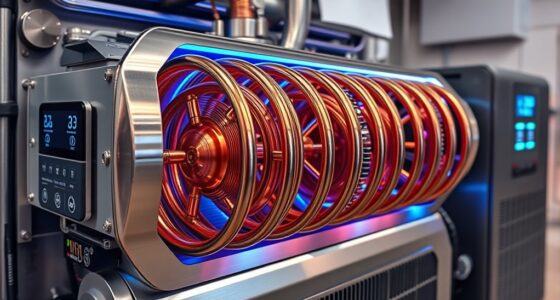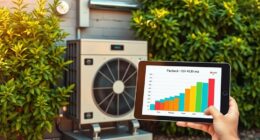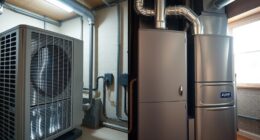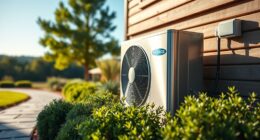We are committed to solving the mysteries of the refrigeration cycle in heat pumps.
We’ll delve into the inner workings of this fascinating system, exploring its components and step-by-step process.
Our goal is to shed light on the heat transfer and compression that drive the cycle, while also explaining its efficiency.
Whether you’re a technician troubleshooting common issues or simply curious about how it all works, join us as we unveil the mysteries of the heat pump refrigeration cycle.

Key Takeaways
- The heat pump refrigeration cycle transfers heat from a low-temperature source to a high-temperature sink.
- Understanding the components and process of the cycle is essential for energy efficiency and maintenance.
- Maximizing efficiency of heat transfer is crucial and can be achieved through factors such as insulation, surface area, and fluid flow.
- Optimizing refrigerant flow, including proper selection and control, is important for system performance.
The Basics of a Heat Pump Refrigeration Cycle
In our discussion of the basics of a heat pump refrigeration cycle, let’s explore its fundamental components and operation.
A heat pump operates by transferring heat from a low-temperature source to a high-temperature sink, utilizing the properties of a refrigerant. The refrigerant plays a crucial role in this process, as it undergoes phase changes and absorbs or releases heat.
The properties of the refrigerant, such as its boiling point and specific heat capacity, dictate the efficiency and performance of the heat pump. By changing the pressure and temperature of the refrigerant, the heat pump can extract heat from the source and deliver it to the sink.
This cycle of compression, condensation, expansion, and evaporation allows the heat pump to provide heating or cooling for various applications. Understanding the operation and characteristics of the refrigerant is essential for optimizing the efficiency and effectiveness of heat pump systems.

Understanding the Components of a Heat Pump Refrigeration Cycle
Let’s take a closer look at the components of a heat pump refrigeration cycle to understand how they work together to transfer heat efficiently. The key components of a heat pump refrigeration cycle include the evaporator, compressor, condenser, and expansion valve.
The evaporator is responsible for absorbing heat from the indoor air and converting it into a gaseous refrigerant. The compressor then increases the pressure and temperature of the refrigerant, making it ready for the next stage.
Next, the refrigerant flows into the condenser, where it releases heat to the outdoor air, causing it to condense into a liquid state. Finally, the expansion valve reduces the pressure of the refrigerant, allowing it to return to the evaporator and continue the cycle.
Understanding these components is crucial for optimizing energy efficiency and ensuring proper heat pump maintenance. Regular maintenance, such as cleaning the coils and checking for refrigerant leaks, can help maintain the performance and efficiency of the heat pump.

Step-by-Step Process of a Heat Pump Refrigeration Cycle
As we delve into the step-by-step process of a heat pump refrigeration cycle, we can gain a deeper understanding of how heat is transferred efficiently.
Here are the key steps involved in this process:
-
Evaporation: The refrigerant absorbs heat from the surrounding air or water, causing it to evaporate and turn into a gas.
-
Compression: The compressor increases the pressure of the refrigerant gas, which raises its temperature.

-
Condensation: The hot refrigerant gas is then passed through a condenser, where it releases heat to the surroundings and condenses back into a liquid.
To ensure the smooth functioning of a heat pump refrigeration cycle, it’s important to perform regular maintenance and employ troubleshooting techniques. Regularly cleaning or replacing filters, checking for leaks, and ensuring proper airflow are some maintenance tips that can help optimize the system’s performance.
Understanding the step-by-step process and implementing maintenance techniques will pave the way for effective heat transfer in a heat pump refrigeration cycle.
Heat Transfer in a Heat Pump Refrigeration Cycle
When it comes to heat transfer in a heat pump refrigeration cycle, the efficiency of the process is of utmost importance. Optimizing the flow of refrigerant plays a crucial role in ensuring efficient heat transfer.

Efficiency of Heat Transfer
Our goal is to maximize the efficiency of heat transfer in the heat pump refrigeration cycle. To achieve this, we can focus on heat transfer enhancement and thermal conductivity improvement. Here are three key factors to consider:
-
Insulation: By improving the insulation of the heat pump system, we can minimize heat loss and maintain a higher level of efficiency. This can be achieved through proper insulation materials and techniques.
-
Surface area: Increasing the surface area of the heat exchanger can enhance heat transfer. This can be done by using fins or other heat transfer enhancement techniques to maximize the contact between the refrigerant and the surrounding environment.
-
Fluid flow: Optimizing the flow of the refrigerant within the system can improve heat transfer efficiency. This can be achieved by designing the system to reduce pressure drops and ensure a uniform flow distribution.

By implementing these strategies, we can enhance the efficiency of heat transfer in the heat pump refrigeration cycle, leading to improved performance and energy savings.
Now, let’s move on to the next section about optimizing refrigerant flow.
Optimizing Refrigerant Flow
To optimize heat transfer in a heat pump refrigeration cycle, we focus on improving the flow of the refrigerant through the system. Proper refrigerant selection and flow control are crucial factors in achieving efficient and effective heat transfer.
The choice of refrigerant is important as it affects the overall performance of the heat pump system. Factors to consider when selecting a refrigerant include its thermodynamic properties, environmental impact, and safety regulations.

Optimal flow control is achieved through the use of expansion valves and variable speed compressors, which allow for precise regulation of the refrigerant flow rate. By ensuring that the refrigerant flows smoothly and consistently through the heat pump system, heat transfer efficiency is maximized, leading to improved performance and energy savings.
The Role of Compression in a Heat Pump Refrigeration Cycle
In the heat pump refrigeration cycle, compression plays a vital role in increasing the temperature and pressure of the refrigerant. This is achieved through the use of a compressor, which compresses the refrigerant gas and raises its temperature.
Here are three important points to understand about the role of compression in the heat pump refrigeration cycle:
-
Compressor Efficiency: The efficiency of the compressor is crucial in ensuring the proper functioning of the heat pump. A more efficient compressor will require less energy to achieve the desired temperature and pressure increase, resulting in lower energy consumption and cost.
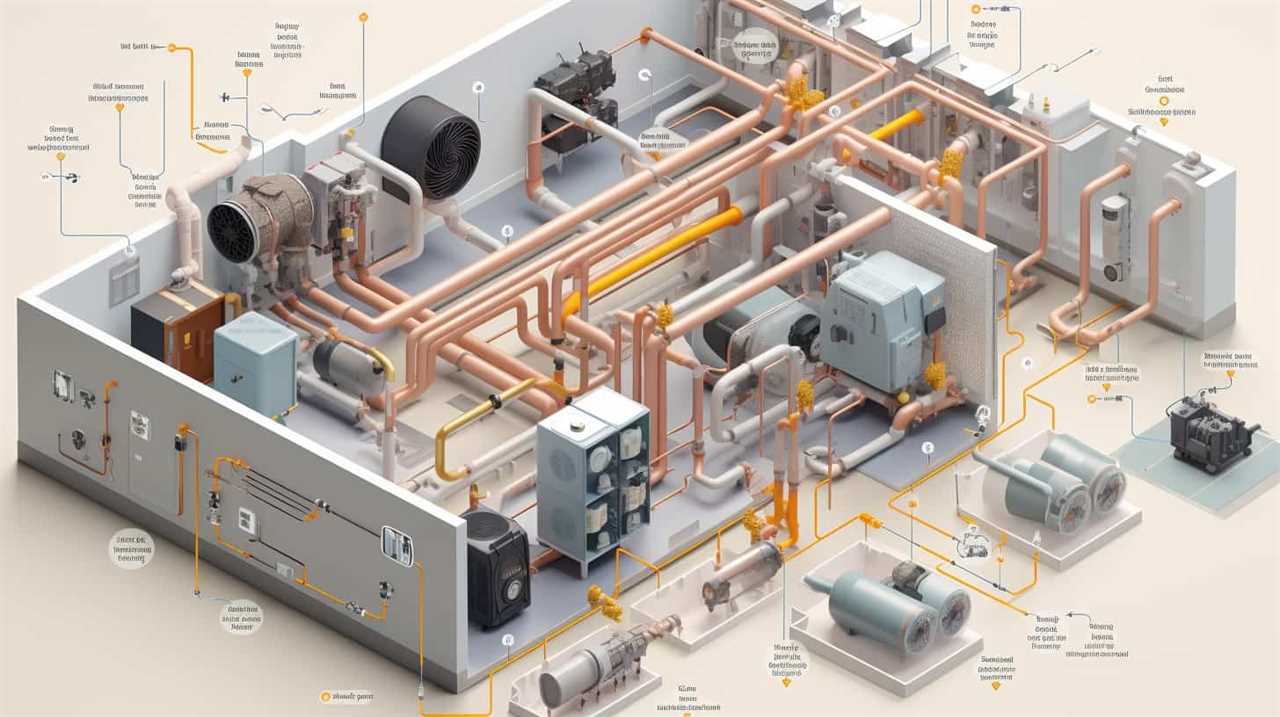
-
Refrigerant Properties: The properties of the refrigerant, such as its specific heat capacity and boiling point, greatly influence the compression process. Understanding these properties helps in selecting the right refrigerant for optimal heat transfer and overall system efficiency.
-
Pressure-Volume Relationship: Compression causes the refrigerant to move from a low-pressure region to a high-pressure region, resulting in an increase in its temperature. This relationship between pressure and volume is fundamental to the operation of the heat pump refrigeration cycle.
Heat Pump Refrigeration Cycle Efficiency Explained
When discussing the efficiency of a heat pump refrigeration cycle, there are several key points to consider.
The first is the Coefficient of Performance (COP), which measures the ratio of heat output to the energy input. This is an important metric in determining the overall efficiency of the heat pump.
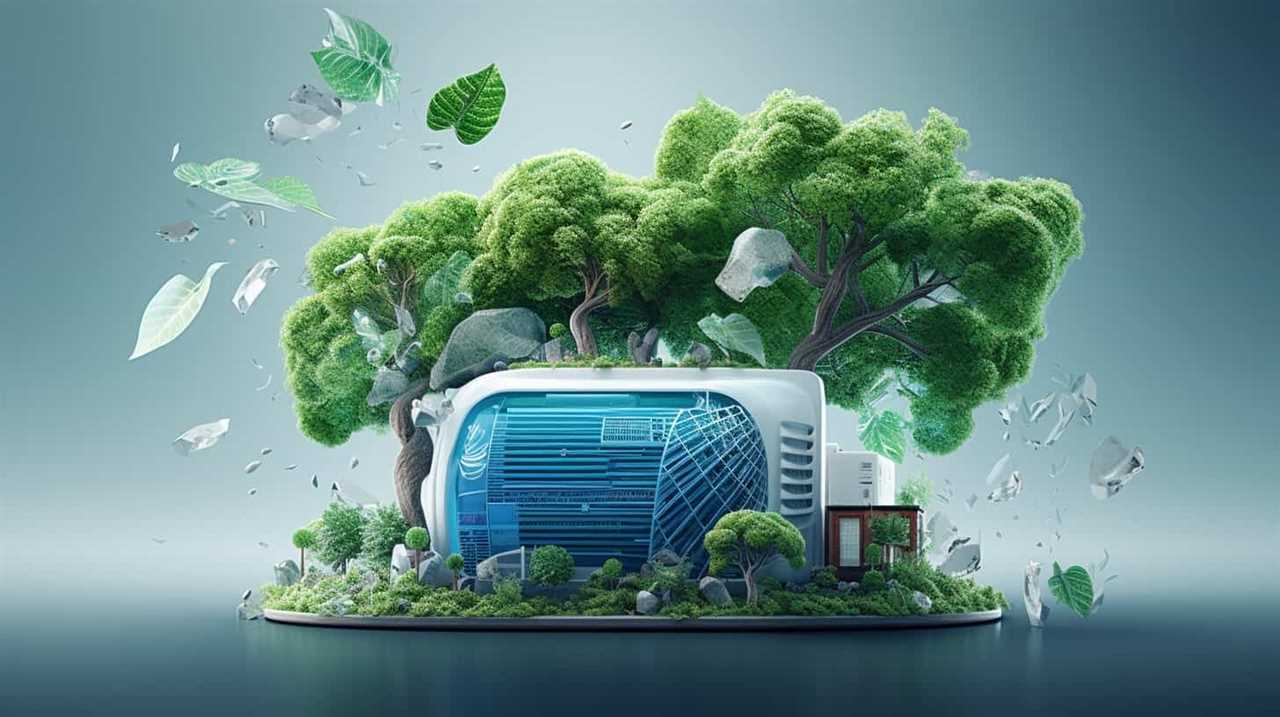
Additionally, energy-saving technology plays a crucial role in maximizing efficiency, such as variable-speed compressors and smart control systems.
Lastly, understanding the heat transfer mechanisms involved in the cycle, including conduction, convection, and radiation, helps optimize the system for optimal efficiency.
Coefficient of Performance
We can measure the efficiency of the heat pump refrigeration cycle by calculating its coefficient of performance. This metric allows us to determine how effectively the heat pump is transferring heat from one location to another.
Here are three key aspects to consider when discussing the coefficient of performance:

-
Energy Efficiency: The coefficient of performance indicates the ratio of heat output to the amount of electrical energy input required by the heat pump. A higher coefficient of performance means the heat pump is more energy-efficient, resulting in lower energy consumption and cost savings.
-
Heat Pump Maintenance: Regular maintenance is crucial to ensure the heat pump operates at its optimal performance. Factors such as proper refrigerant levels, clean filters, and well-functioning components can positively impact the coefficient of performance.
-
System Design: The coefficient of performance can also be influenced by the design of the heat pump system. Proper sizing, insulation, and ductwork play a significant role in maximizing efficiency.
Understanding the coefficient of performance helps us identify areas for improvement and optimize the heat pump’s energy efficiency.

Now, let’s delve into the next section, which explores energy-saving technology.
Energy-Saving Technology
Our article will now delve into the energy-saving technology that enhances the efficiency of the heat pump refrigeration cycle. Energy-efficient solutions play a vital role in reducing the environmental impact of HVAC systems. By incorporating advanced technology and innovative design, heat pump refrigeration cycles can achieve higher levels of efficiency, resulting in significant energy savings.
One such energy-saving technology is variable-speed compressors. These compressors can adjust their speed based on the cooling or heating demands of the space, ensuring that the system operates at optimal efficiency without unnecessary energy consumption. Additionally, the use of intelligent controls and sensors helps optimize the system’s performance by monitoring and adjusting various parameters in real-time.
Heat Transfer Mechanisms
To enhance the efficiency of the heat pump refrigeration cycle, we employ various heat transfer mechanisms that enable optimal heat transfer between the refrigerant and the surrounding environment. These heat transfer mechanisms play a crucial role in maintaining the desired temperature and maximizing energy savings.

-
Convection: By utilizing convection, heat is transferred through the movement of fluid or air. As the refrigerant absorbs heat from the surroundings, it becomes hotter and rises, allowing cooler air or fluid to take its place and continue the heat transfer process.
-
Conduction: Conduction involves the direct transfer of heat through a solid material. The refrigerant, as it flows through the heat exchanger, comes into contact with the solid walls, transferring heat through the process of conduction.
-
Radiation: Radiation is the transfer of heat through electromagnetic waves. In the heat pump refrigeration cycle, radiation occurs when heat is emitted or absorbed by the refrigerant and surrounding environment.
Troubleshooting Common Issues in a Heat Pump Refrigeration Cycle
Identifying and addressing common issues is essential for maintaining the efficiency of a heat pump refrigeration cycle. Troubleshooting techniques can help diagnose and resolve these issues, ensuring that the heat pump operates optimally.

One common maintenance issue is inadequate airflow, which can be caused by dirty air filters or obstructed vents. To address this, regularly clean or replace air filters and ensure that vents are clear of any debris.
Another issue is refrigerant leaks, which can result in reduced cooling or heating capacity. Detecting and repairing these leaks is crucial for restoring the system’s performance.
Additionally, electrical problems such as faulty wiring or malfunctioning components can disrupt the heat pump’s operation. Regular inspections and maintenance checks can help identify and resolve these issues promptly, ensuring the smooth functioning of the heat pump refrigeration cycle.
Frequently Asked Questions
What Are the Different Types of Refrigerants Used in a Heat Pump Refrigeration Cycle?
There are various refrigerant types used in a heat pump refrigeration cycle. These include R-410A, R-134a, and R-32. Each has its advantages and suitability for specific applications. Heat pumps offer efficient heating and cooling solutions for homes.

How Does the Size of a Heat Pump Affect Its Efficiency?
The size of a heat pump is crucial to its efficiency. A larger heat pump can provide more heating or cooling power, but it may also consume more energy, leading to higher heating and cooling costs.
Can a Heat Pump Refrigeration Cycle Be Used for Cooling Purposes Only?
Yes, a heat pump refrigeration cycle can be used for cooling purposes only. However, it is important to consider heat pump efficiency and perform regular heat pump maintenance to ensure optimal performance and energy savings.
Are There Any Environmental Concerns Associated With the Use of Heat Pump Refrigeration Cycles?
There are some environmental concerns associated with heat pump refrigeration cycles. These include the potential for refrigerant leaks, which can contribute to climate change, and the use of electricity, which may not always be generated from renewable sources. However, heat pump refrigeration cycles are generally more energy efficient than other cooling systems, which can help reduce overall environmental impact.
What Are the Main Factors That Can Affect the Lifespan of a Heat Pump Refrigeration Cycle?
Factors affecting the lifespan of a heat pump refrigeration cycle include regular maintenance requirements, such as cleaning the filters and coils, as well as proper installation and sizing of the system.

Conclusion
In conclusion, understanding the heat pump refrigeration cycle is crucial for efficient cooling and heating systems.
One interesting statistic that may surprise you is that heat pump refrigeration cycles can achieve an impressive efficiency of up to 300-400%, meaning they produce more energy than they consume.
This remarkable efficiency not only saves energy but also reduces carbon emissions, making heat pump refrigeration cycles a sustainable and environmentally friendly choice.




